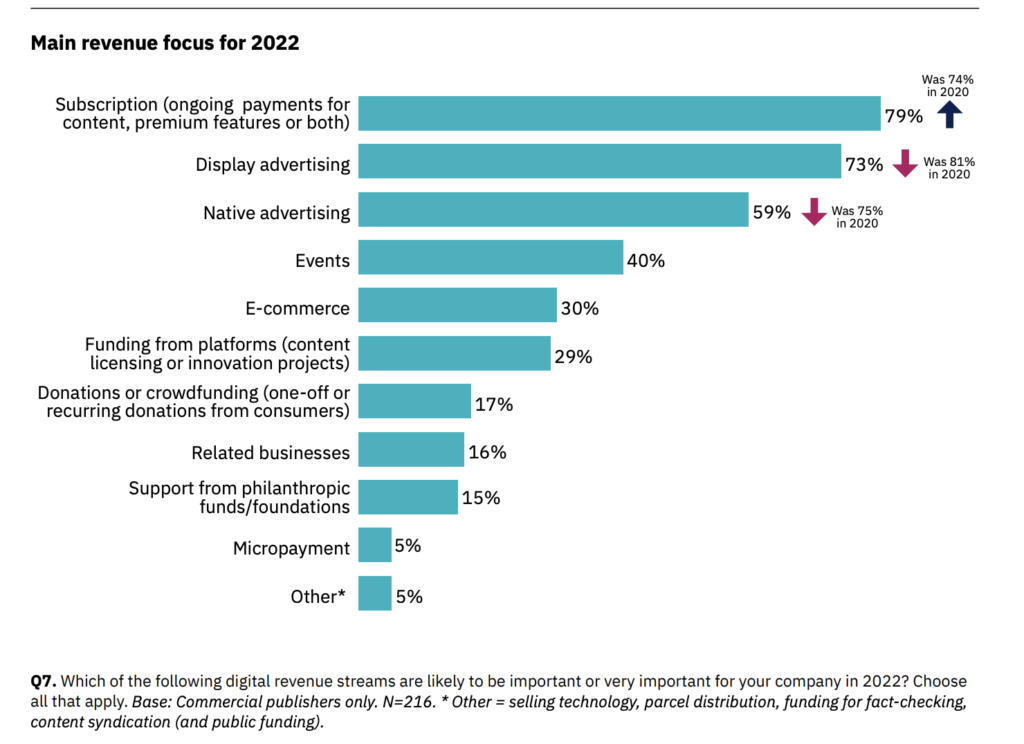How does the Digital News Report 2022 apply to specialist publishers?
The RISJ Digital News report is a thorough survey of senior editors in news organisations around the world, so it is a useful barometer of the health of digital news business models. But how relevant are their findings to specialist consumer and B2B publishers? I have picked out six trends that can be applied to niche media.
1. Revenue focus on digital subscriptions
No surprise that almost 80% of news organisations are focussing on subscriptions revenue (although display and native advertising remain important). This is on balance good for specialist publishers as audiences are becoming more accustomed to meters and paywalls. And subs tech platforms are becoming more sophisticated and affordable. But there is a risk of subscription fatigue, and people rationalising the number of paid subscriptions they have. So niche media must really emphasise the unique nature of their content.
Large news organisations are bundling in extras to retain subscribers – from newsletters to podcasts or specialist content – a tactic worth copying.
Other popular revenue sources include events, e-commerce, and content licensing. But micropayments have yet to take off.
2. Creating new content formats

Audio is booming: 80% of news organisations are planning to invest in podcasts and other digital audio. But almost as many - 70% - are investing in the ‘old school’ format of email newsletters. And digital video in both short form and long form is not far behind at 63%. However, few are interested in putting resources into Alexa, Siri or the metaverse just yet.
Anecdotally, many specialist publishers have already launched podcasts, and sponsorship interest is growing. New Scientist has recently started offering audio versions of longer articles to subscribers, quite separately to their podcasts. As people build in listening to their travel time or chore time, this could also be relevant to niche markets.
Email newsletters are still one of the best traffic drivers for publishers. But there is also a trend to provide exclusive summaries and briefings by email for subscribers – the intent here is as much retention as click through rates.
Video in all its forms is an area of interest. For specialist publishers, virtual events are a useful engine for creating high quality video clips. And many have created studio space for editorial video in their now lightly used offices.
3. Experimenting with AI

Artificial intelligence is becoming a mainstream tool for news organisations. The most popular applications are automated recommendations and subscriber propensity models. There’s also interest in newsroom automation tools, including tagging, transcription, assisted subbing. However, using AI for newsgathering and writing articles is still in its early days.
One interesting example is Sky TV, who have used AI to scrape public health data from government PDFs and update charts and webpages in real time. Washington Post has automated the creation of synthetic voice versions of articles.
For smaller media businesses without in-house tech teams there are a growing number of third-party tools using AI. Some examples were shared in this write-up of a panel I chaired at the Publishing Show.
4. Challenge of remote working

Every part of the world has had to deal with lockdowns and working from home. The survey shows that while there have been gains in efficiency and staff wellbeing, remote teams are less effective at collaboration and creativity.
I reached similar conclusions in this article on the challenge of blended or hybrid working.
5. Generational change
News media audiences are ageing fast, and most news organisations are keen to appeal to younger demographics. This is being achieved by promoting diversity in newsrooms, continuing the move towards digital media and social platforms, plus a focus on topics like climate change and mental health. Tortoise in the UK has certainly focussed on younger readers, with its emphasis on audio content and investigations that appeal to that audience.
Specialist publishers are likely to face a similar cliff edge as their boomer readers retire and the new generation of enthusiasts or business decision makers are digitally native millennials. Worth considering how you evolve both the topics you cover and the formats you use as this wave approaches.
6. Scaling and M&A
Be ready for more mega-mergers and acquisitions as large media organisations look for scale. This might distract them allowing well targeted specialists to dominate niches while they all chase the mainstream. But it could create opportunities too as mass media businesses acquire niche players. Axel Springer recently acquired Politico and The New York Times paid top dollar for The Athletic.
You can download the full RISJ Digital News Trends report here.
If you’d like to discuss how you can adapt your specialist media business to take advantage of some of these trends, do get in touch for a chat over a real (or virtual) coffee.
About the author
Carolyn Morgan has bought, sold, launched and grown specialist media businesses across print, digital and live events. A founder of the Specialist Media Show (sold in 2014) she now advises media businesses large and small on their digital strategy through her consultancy Speciall Media.
Find out more about the advice we provide for publishers

